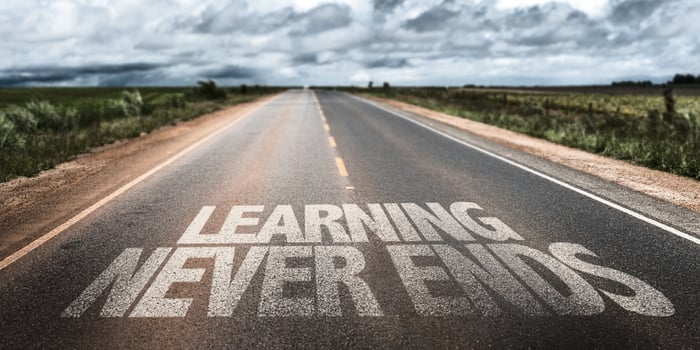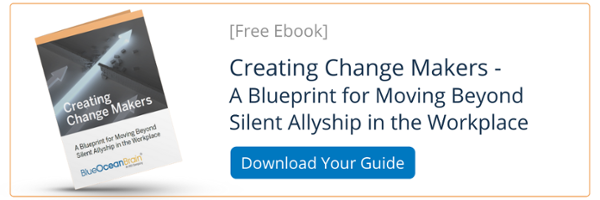By now, it's unlikely that there are any organizations of any size in any industry that don't understand—at least philosophically—the importance and value of diversity, equity, and inclusion (DEI).
But what they may not so readily understand are the actional, practical, and tactical steps they can take to bring their leadership, management, and frontline staff along in their journey to create and maintain a culture supportive of DEI.
Creating a strong culture that supports DEI isn't the sole responsibility of a Chief Diversity Officer (CDO)—although this C-level position has become increasingly common in many organizations. It's not the sole responsibility of the HR department. It's not the sole responsibility of senior leaders. Yes, all three of these groups will play an important and foundational role in creating and supporting a strong DEI culture. But, in truth, to be effective in building and sustaining such a culture requires support and effort from everyone in the organization.
Healthy cultures of diversity, equity and inclusion need ongoing care and feeding. They require the vocal and active support of allies throughout the organization to set the tone, shine a light on inequitable processes and behaviors, and model a standard for true inclusion and belonging.
What does being an ally mean?
An ally stands up for a person or group that is being targeted or discriminated against—even when the situation is unintentional. Allies take action to empower other people, serving as strong role models and active participants in companies' quests to build a strong culture in support of DEI. Allies recognize their own privilege and use it to influence inclusion and call out or challenge behavior that perpetuates bias.
In an article for Harvard Business Review, Be a Better Ally, the authors comment on allyship:
"We view allyship as a strategic mechanism used by individuals to become collaborators, accomplices, and co-conspirators who fight injustice and promote equity in the workplace through supportive personal relationships and public acts of sponsorship and advocacy.
[Allies can play an important role] in improving workplace policies, practices, and culture."

Being an ally is a journey. It's a process that occurs over time and will shift and change as internal and external environments change. It's important not to become frustrated with the process and to recognize that you will be on this journey for the long term. Your organizations, its leaders, and all employees need to have open minds about learning and changing—including being able to change your opinions.
Gail Rudolph, best-selling author of Power Up Power Down: How to Reclaim Control and Make Every Situation a Win/Win, remarks:
"As humans, we all want to be included and accepted, and I don't believe that most people consciously wish to exclude others. Yet we have fallen short on effectively creating fully diverse, equitable, and inclusive organizations, cultures, and environments."
Allies can help to do that by expanding the organization's influence beyond the CEO or senior leadership team. Getting everybody on board as active allies strengthens organizations, reinforcing culture and visibly building a supportive and inclusive work environment.
Why is it important to be an ally?
A single CDO or HR leader can't build and sustain change across an organization regardless of its size. And even if the entire leadership team is also committed to this journey, they simply can't achieve culture change on their own, no matter how small the organization may be. Of course, creating that culture would be a herculean effort in large organizations.
It takes a village.
Rudolph points to a 2015 Harvard Business Review study where 89% of those surveyed said they had been unfairly treated at work due to someone else's bias. Things are certainly not much better today.
A 2019 study by Brandon Hall indicated that 96% of employees feel that management bias affects performance review scoring.
When employees act as allies, that becomes part of a force multiplier effect—amplifying efforts to drive change and create a diverse, inclusive, respectful, and supportive culture.
Allies help foster positive relationships across the organization, using their influence to help others be successful. Allies' credibility can help create and support a more inclusive work environment, supporting underrepresented groups by boosting their voices.
Rudolph explains:
"[DEI] is maximized when every individual, no matter their role, race, age, or sexual orientation, can effectively harness their power and influence to advance the organization's goal and mission of creating a diverse and inclusive culture."
These people are allies.
But it’s action, not talk or even internal beliefs, that leads to successful change.
Successful change requires more than talking about being an ally
Tenzin Gyatso, the fourteenth Dalai Lama, said:
"It is not enough to be compassionate. You must act."
That's certainly true of allies.
Organizations often have training sessions or initiatives to teach employees what it means to be an ally and the importance of being an ally. But, despite many employees agreeing that, yes, this is an important role, successful change requires action, not just talk.
As Karen Catlin, author of Better Allies, says:
"Helping individuals is laudable, but the responsibility of allies is to take actions that will have lasting, beneficial effects on systems."
Organizations can help to set the stage for an environment where allies do more than talk, says Diana Patton, a former civil rights attorney, social justice advocate, and founder of the Rise Advocates Academy. Patton, herself an African American, says that her climb up the corporate ladder to executive-level positions within Fortune 500 companies gave her perspectives about what companies can do at the leadership level to set the stage for change:
- Conduct a leadership diversity audit to assess your leadership’s aptitude for embracing diversity, equity, and inclusion.
- Help your leadership understand the importance of embracing and sharing their personal stories.
- Give your leadership tools to help them encourage courageous conversations at work
- Supply your leadership with a three-month strategic plan on creating a culture of inclusion and invite staff to give input along the way.
- Consistently encourage and model the values of humility, service, compassion, and teamwork.
It’s not easy being an ally. But effective allies do what’s right—not necessarily what’s easy.
Creating an impact on DEI in the workplace
When they initially consider how to build a workforce that supports DEI, many organizations think first of the recruitment process. But, while hiring people from diverse backgrounds and promoting diversity initiatives are important, they really represent only the tipping point of the cohesive, intertwined—and strategic—steps companies must take to create an impact on DEI.
Diversity, equity, and inclusion go hand in hand. To experience true organizational change, companies must create a truly inclusive work culture. That requires focusing on several important actions.
Casting a wide net to attract (and retain) diverse employees
Employers use some tried and true methods to recruit new employees that, however unintentional, can work against their desire to recruit diverse candidates—for instance, employee referrals. Employees are likely to refer people like themselves; if your current employee population is not diverse, chances are they will not refer diverse candidates to you.
To cast a wider net, take a look at your current sources and consider how you might broaden your reach. For instance, the schools you reach out to, the trade journals or publications you run ads in, the social media channels or groups you recruit from.
In addition, consider the criteria you use for evaluating candidates. Many employers today say that they hire for "fit." As Anjela Mangrum, president of Mangrum Career Solutions, a manufacturing recruiting agency and executive search firm, points out, that could be a barrier. She recommends shifting the focus in hiring from cultural "fit" to cultural "add." She says that a focus on fit can:
"...lead to the opposite of diversity, where workers who are unlike the majority of your workforce feel pressured to conform to your culture and fit in."
She suggests it's important to value differences and consider how they can help you "evolve your company culture."
Promoting pay equity
Pay equity is a pervasive problem these days, SHRM reports, citing research from PayScale indicating that “for every $1 paid to white men, Black men earn 88 cents and Black women receive 76 cents.” Even when adjusted to compare those with similar education and experience levels, a gap remains—98 cents for Black men and 97 cents for Black women. As with many disparities found in the workplace, these gaps are not likely to be intentional. And yet they persist.
SHRM recommends a number of steps HR can take to promote pay equity, including:
- Getting buy-in from the C-suite
- Conducting a pay audit
- Setting aside some budget to address any discrepancies discovered through the audit
- Not asking for pay history when hiring
- Practicing transparency when reporting your findings
- Creating discussions about the root causes of any inequities
- Limiting manager discretion in pay decisions
What gets measured gets managed. Looking objectively at your pay practices can help you promote pay equity.
Building inclusive people leaders
Your people leaders are instrumental in fostering inclusion and allyship. With their direct impact on the day-to-day employee experience, and their involvement in the many decisions around hiring, promotion, and performance management, they are heavily involved in the success or failures of your organization's DEI goals.
Communicating the importance of managing bias
Companies can pay a high price for bias—not just from a legal, regulatory, or compliance point of view but also in terms of lost opportunities.
In referring to the many people feeling unfairly treated and the subject of bias at work, Rudolph says:
"How many great ideas were snuffed out because of this exclusion?
How many amazing employees left companies?
How much creativity, problem-solving, and collaboration has been left on the sidelines because people are shut out and made to feel as though they don't belong?
[There are] tremendous benefits for embracing DEI."
And she points to data to back that up.
Forbes has reported that inclusive teams make better decisions up to 87% of the time—and they do so twice as fast and require half as many meetings. They also deliver 60% better results. And Bain & Co. says that “effective decision making is 95% correlated with financial performance.
Being aware of unconscious bias
We all have biases of various kinds—many we're not even aware of—that impact how we interact and respond to others daily. In fact, writing for SHRM, Kathy Gurchiek reports:
"Most people have some type of hidden bias, according to the NeuroLeadership Institute. Such biases often surface in the workplace when people are drawn to others who share the same hobbies or pursuits, creating an affinity bias that can affect resume-screening and career advancement."
Unfortunately, while many companies focus on DEI training and, specifically, unconscious bias training, there's evidence to suggest that what they've been doing simply isn't working!
For instance, a Harvard Business Review article reports that a 2019 meta-analysis of more than 490 studies of about 80,000 people by psychologist Patrick Forscher and his colleagues found that unconscious bias training didn't change behaviors. And they report that other studies have indicated this training can actually have negative impacts, which:
"[Sends] the message that biases are involuntary and widespread—beyond our control, in other words—can make people feel they're unavoidable and lead to more discrimination, not less."
The most effective training, they say, doesn’t just raise awareness of bias:
“It teaches attendees to manage their biases, change their behavior, and track their progress.”

Developing a strategic DEI learning program
Strategy matters when it comes to implementing initiatives over time to strengthen companies’ DEI cultures. That encompasses being strategic in your learning and development efforts around DEI.
Notice the important distinctions between “training” and “learning”. Training programs are usually one-and-done, focused on compliance, and occur via “push” methods such as classroom training or required powerpoint modules that typically fail to result in the learning retention and application needed to see real results. Learning programs, when designed effectively, are ongoing, multimodal, combine a variety of topics, and draw learners in with inclusive, accessible content.
When building a learning program, ask yourself: What are the actual outcomes you’re looking for?
Where do you need to see these outcomes?
Will this program be accessible to everyone in the organization?
How will you measure success over time?
Are we designing this program to be a journey? Or a destination? Hint: Your answer should be a journey!
Nance L. Schick, Esq., is Chief Resolution Officer with Third Ear Conflict Resolution. She’s an employment attorney, ethno-religious mediator, and diversity trainer—and a former HR supervisor back in the days, as she puts it, “when hair was considered ‘professional’ only if straightened on women and above the collar on men.”
The problem with many companies' approaches to strengthening DEI, she says, is that they:
"Focus on checking the boxes without considering why boxes need to be checked."
Mindset, she says, determines where and how to focus limited resources like time, money, and energy. But she points out that:
"Business leaders are rarely focusing on the possibilities of diversity causing major breakthroughs in the business. [Instead, they focus on DEI support as] a corrective measure to quiet protestors or objectors, or it's seen as an opportunity to ride the latest trends."
However, there is an opportunity for business leaders and their leadership and support teams to take a more strategic approach to learning and communication around DEI.
Listening to employees
Listening to employees is critical to any DEI initiative. Establishing a transparent climate where employees feel safe and comfortable expressing their feelings, concerns, ideas, and recommendations can yield valuable insights on opportunities for improvement. Their input can also help you ensure that you are not inadvertently doing things that may adversely impact certain employee groups.
Mangrum notes that paying attention to workers' unique needs is important.
"Whether it's a recreational activity or a religious event, staying respectful of your team members' unique backgrounds is essential to creating a culture that celebrates diversity. For instance, team members who can't eat beef or pork for religious reasons should be accounted for when arranging a corporate dinner."
You might be unaware of these things, but being unaware creates a less-than-ideal climate for inclusiveness and belonging for marginalized employees.
Supporting DEI with meaningful actions
As noted, creating and sustaining a strong culture supporting DEI is a process, not an event. It's a process that benefits from a myriad of actions—sometimes seemingly small actions—by people across the organization.
So, what can you do, and what can you encourage your colleagues, employees, and others to do? Here we look at some specific, meaningful actions you can take and teach to support DEI in meaningful ways.
Evaluate your hiring practices.
Communication
Ensure that all of the communication materials you use in the hiring process use inclusive language and images and represent a variety of lived experiences. Ask employees from diverse backgrounds to aid in your review and point out anything they feel may be sending unintended messages.
The interview
Create an inclusive interview process. Again, involving your employees as allies can ensure that you get a broad perspective and multiple inputs when considering candidates. They can help review questions and evaluation documents and participate in the actual interview.
Candidate qualifications
Emphasize candidates' qualifications. Focusing on qualifications rather than personal attributes can help to ensure that you're considering what candidates can do rather than who they are. Is a certain level of education really required, or do the candidate's past experiences and knowledge better indicate proficiency for a certain role?
Encourage ongoing learning and education.
Ongoing learning can help build active allies and maintain their commitment and engagement over time. Learning programs can cover a wide range of related topics such as empathy, racial considerations, LGBTQIA+ issues, cultural appreciation, developing a growth mindset, having courageous conversations, active listening, etc.
It’s important that these learning and education activities are reflective of, and accessible to, the many diverse groups, levels, and functions within the organization. It can be useful, too, to get input and insights from employees about the topics they may be most interested in or need more direction to help them better understand and respond to situations they face regularly.
Use your influence to help underrepresented groups thrive.
As BCG says:
"It’s frontline leaders who make or break progress on diversity, [which is] particularly critical in implementing large cultural changes such as diversity and inclusion (D&I) initiatives, where even the best-intended programs will fail if they don’t have the right support at all levels."
When leaders leverage their influence to purposefully help underrepresented groups thrive, they lend their support as active allies, which can help marginalized employees be more visible, more involved, and more likely to move into higher-level positions. People leaders can do some relatively simple but very powerful things to elevate their marginalized colleagues and team members.
For instance, in her book Better Allies, Karen Catlin suggests:
- When giving a presentation, take the first question from an employee from an underrepresented group.
- When planning an event, reach out to promote the event to underrepresented groups.
- When holding a meeting, include staff members from marginalized teams to give updates.
Consider the power your efforts could have in helping to create a climate of inclusion and belonging where employees feel comfortable bringing their whole selves to work and understand that they are valued.

Helping underrepresented individuals advance their careers
Hiring diverse candidates isn't all it takes to build and sustain a strong DEI culture. It's just the first step. Once onboard, it's critically important to ensure that these diverse candidates feel welcomed, valued, and supported. They need to feel that they are part of the team, respected and that their input and opinions matter.
Joyce Chiao, founder and CEO of InclusionLabs, says organizations must address any elements of their culture that may be contributing to exclusion and hindering diversity efforts. She adds:
"Even if organizations are able to increase the diversity of their workforce through hiring efforts, they are likely to see continued attrition from the same employees they invested so much time and energy to hire."
She also recommends going beyond basic hiring data to drill into important details:
"The hiring data might show that an organization has successfully increased the diversity of their workforce, but what do we see happening throughout the employee lifecycle?
Are we finding higher rates of attrition from BIPOC employees? Are LGBTQ+ women of color reporting lower levels of employee engagement or satisfaction? Looking at the employee experience after hiring can provide a critical window into the pulse of your organization."
Here, again, there are a number of specific actions you can take to help potentially marginalized workers achieve their full potential:
- Be a mentor, but don’t just mentor people like you; make an effort to reach out to those who are not like you; you’ll both learn more in the process.
- Be a sponsor, again seeking to sponsor those who are not like you. Sponsors take a more active role in promoting the success of others by giving them opportunities for visibility, assigning them to stretch assignments, talking about their successes to others, and recommending them for special projects and promotions.
Launch, sponsor, or participate in various employee resource groups (ERGs) to ensure that diverse employees have opportunities to support each other—and to give you insights into their experiences, thoughts and opinions. Allies are your first line—and front line—of defense in building a workplace culture that celebrates and supports the diversity of all of your staff members. Everyone can be an ally. In big and small ways, you and your employees can collectively make a powerful impact every day.
As Rudolph says:
"As humans, we all want to be included and accepted and I don’t believe that most people consciously wish to exclude others. Yet we have fallen short on effectively creating fully diverse, equitable, and inclusive organizations, cultures, and environments."
Thinking strategically about the role that active allies could play in your DEI efforts, and taking actionable steps to ensure DEI is the focus of efforts across the organization, at all levels, can contribute to the development and sustainability of a strong culture. That, in turn, will contribute to strong business results ensuring that organizations are “doing good, while being good.”




